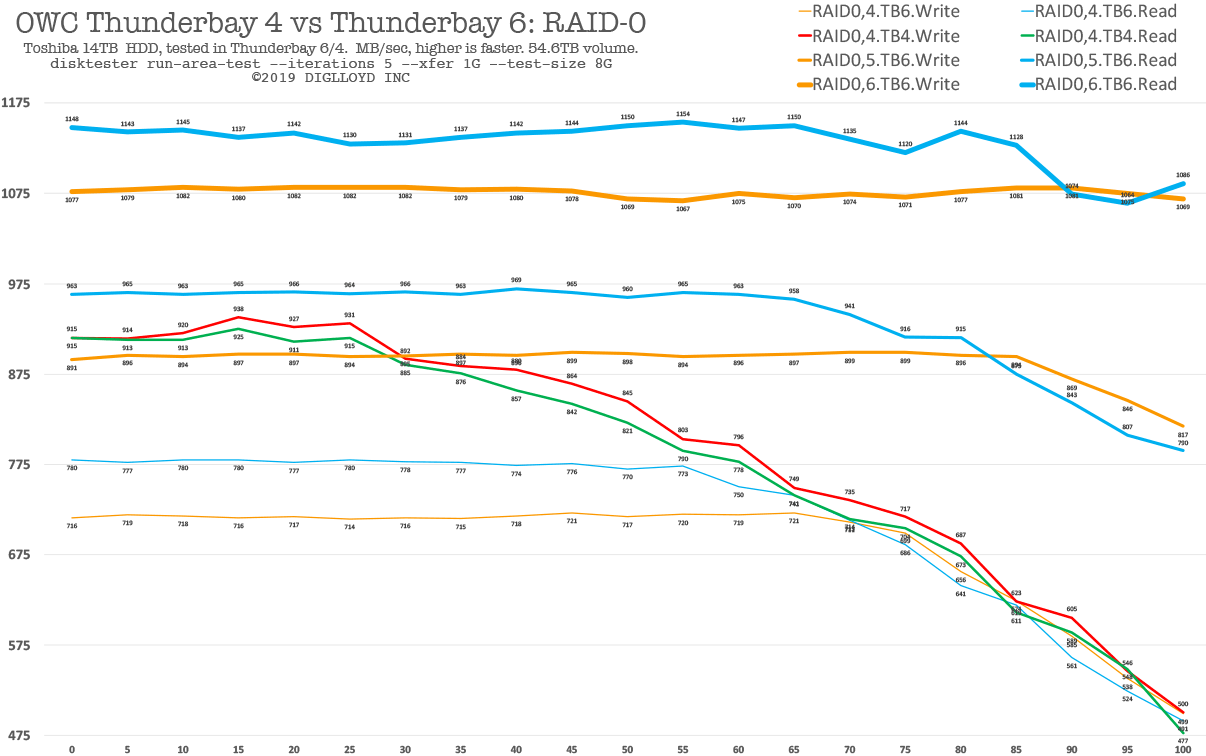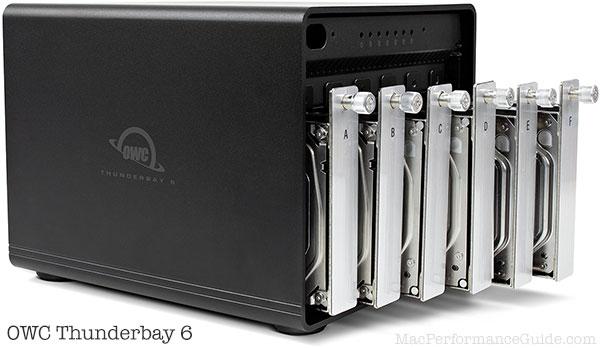
$220 SAVE $130 = 37.0% Western Digital 16.0TB Western Digital Ultrastar DC HC550 3.5-in… in Storage: Hard Drives
|

|

|

|

|

|

|

|

|

|
OWC Thunderbay 6 vs Thunderbay 4: RAID-0 Performance Options
Related: bandwidth, hard drive, Other World Computing, OWC Thunderbay, OWC ThunderBay 6, RAID, RAID-0, RAID-5, storage, Thunderbolt, Thunderbolt 3, Toshiba, weather events
Configurations up to 84TB. Available in RAID edition (includes SoftRAID XT) or standard edition. For a really fast ~56TB of storage, MPG recommends using 14TB drives and forsaking about 1/3 of the slowest part of the storage capacity.
This pages complements the RAID-0 test results; see the testing details on that page.
The OWC Thunderbay 4 has greater total bandwidth to its hard drives than the OWC Thunderbay 6 (four SATA controllers versus three), but the Thunderbay 4 houses only four drives. Thus drive speed becomes a major factor once the drives start to fill up (speed drops dramatically). A natural question is thus whether 5 (or 6) drives can significantly improve upon performance of 4 drives for the same total storage capacity.
Bandwidth is potentiality, not actual performance. Just as Thunderbolt 3 is nominally 40 Gbps in each direction, that’s a nonsense figure as the maximum theoretical data bandwidth with Thunderbolt 3 available excluding video is at most only 32 Gbps for PCI Express Gen 3 (4 X 8 Gbps = 4 GB/sec), and no product on the market as of early 2019 exceeds even 2800 MB/sec. The total performance package is what the device can actually deliver which is then throttled by whatever bandwidth constraints are present.
What might 5 or six hard drives offer over 4?
Since hard drives slow down as they fill up, what if just one additional drive is used (five drives total) in the Thunderbay 6? Or two more? There are plusses and minuses:
- Option for a 6th drive, or leave the 6th bay free.
- Single compact unit for all drives is a win for the Thunderbay 6 (versus cabling and powering dual Thunderbay 4 units).
- For the same 54.6TB capacity, increased performance with five drives because hard drives slow down as they fill up. With a 5th drive, the volume is using substantially faster areas of the (five) drives, versus the entire capacity of only 4 drives.
- Additional 14TB of capacity in 5-drive configuration can be left unused or put to other use.
- Downside: about 30% higher cost for a Thunderbay 6 with 5 drives versus Thunderbay 4.
Test results, RAID-5 with 4/5/6 drives —Thunderbay 4 vs Thunderbay 5
Like all hard drives, the outer tracks are much faster than the inner tracks; see Drive Capacity and Speed. Hence the speed across capacity steadily declines as expected behavior.
Four 14TB drives in the OWC Thunderbay 4 results in a 54.6TB volume. The test below uses that volume size for 4/5/6 drives.
The sweet spot of using five drives in the OWC Thunderbay 6 is seen below, with substantial performance gains starting at about 30% capacity usages, as compared to four drives in the OWC Thunderbay 4 (middle pair of orange/blue lines vs red/green pair).
Capacity utilization of a ~54TB volume is surely more than a few terabytes, so the most relevant performance is around 30% capacity utilization and beyond (30 to 100 range). In that range, the 5-drive RAID-9 substantially outperforms the 4-drive RAID-5 by a large margin. Going to 6 drives, the advantage is about 25% faster to start, and more than twice as fast as full capacity is reached.
In other words: in the real world where data is actually stored and used, the 5-drive configuration is a far superior choice for more than 20TB of capacity utilization. Reliability of a 5-drive stripe might be a concern (drive failure), but in that case the same advantage holds for the fault-tolerance of RAID-5.
The cost difference is about $200 for the enclosure and the cost of one additional drive. The same behavior should hold for any capacity drive. My thinking is thus that in spite of its bandwidth limitations, the OWC Thunderbay 6 with a 5-drive RAID-5 is the sweet spot (I’ll use the sixth drive for backups).
- The red (write) / green (read) lines are the OWC Thunderbay 4 unit with four 14TB drives.
- The three pairs of orange (write) blue (read) lines for for the OWC Thunderbay 6 with 4, 5, 6 drives respectively. The highest lines are for the 6-drive RAID-5, next highest the 5-drive RAID-5, lowest lines are 4-drive RAID-5.
Vertical scale is MB/sec. Horizontal scale shows percentage of volume capacity, e.g., 50% of an 42TB volume is the 21TB mark. All test values were across a 42TB volume with excess space left unused for the 5 and 6 drive RAIDs.

Seagate 22TB IronWolf Pro 7200 rpm SATA III 3.5" Internal NAS HDD (CMR)
SAVE $100

 diglloydTools™
diglloydTools™


